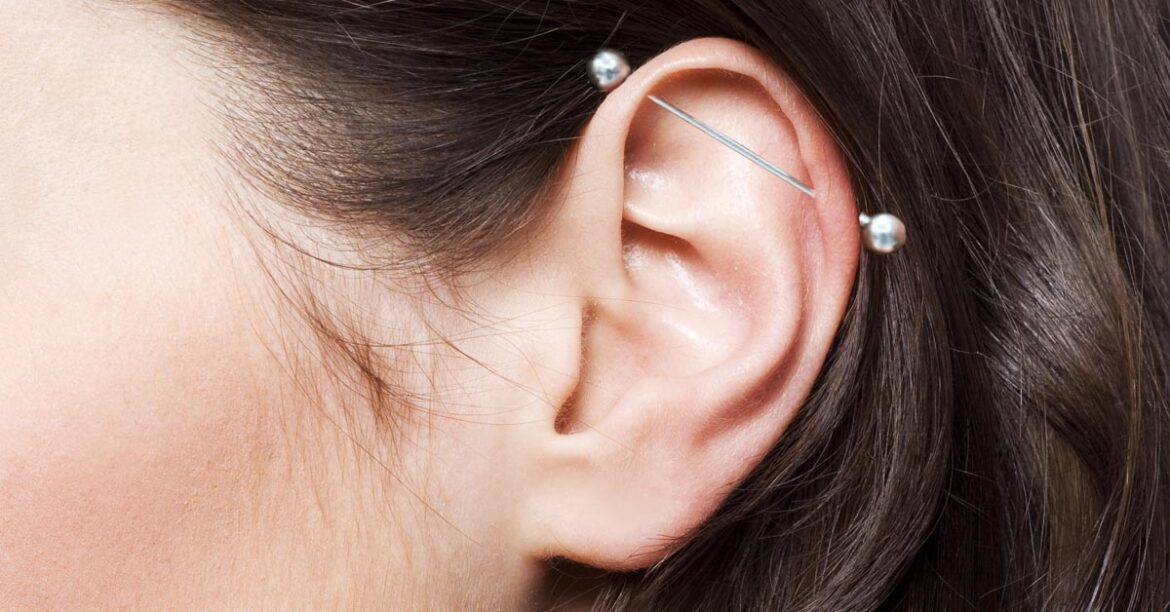What Is Industrial Piercing?
Industrial piercing is a type of body piercing that goes through the fleshy part of the earlobe and then exits
through the cartilage.
The word industrial stands for two pieces of jewelry, rather than just one.
The jewelry used is typically heavier and wider than normal pierced earrings.
Many people get industrial piercings because they like the look of them, and they are often considered a fashion
statement.
Some people get them because they want to stretch their earlobes, while others get them as a way to relieve pain
in their earlobes.
Industrial piercings are not as common as other types of piercings, so they can be difficult to find a qualified
piercer to do them.
For Ear Piercing Interactive Chart Press HERE
What is The History of industrial piercing?
It is thought to have originated in the early 1990s,
although it is not clear exactly where or when it started.
One of the earliest documented cases of an industrial piercing was in a 1994 issue of BME (Body Modification
Ezine), which is a website and magazine dedicated to body modification.
In the article, a woman named Katje Sabel describes getting her industrial piercing done by piercer Eric Dakota.
Sabel is credited with popularizing the piercing in the early 1990s,
and she is thought to be one of the first people to get one.
Dakota is also credited with inventing the “tower” technique for doing industrial piercings,
which is still used today.
Since then, the industrial piercing has become increasingly popular, and can be found in many different parts of the world.
What is The Pain Level of Industrial Piercing?
The pain level can vary from person to person.
Some people report that it is extremely painful, while others say that it is only slightly uncomfortable.
It is generally considered to be more painful than a traditional earlobe piercing,
but less painful than a cartilage piercing.
What are The Risks and Complications of Industrial Piercing?
Like any other type of body piercing, there are risks and complications associated with industrial piercings.
These include:
• Infection – There is a risk of infection anytime you get a piercing, and this is especially true for industrial
piercings, which are more difficult to clean.
Bleeding – There is also a risk of bleeding, especially in the early stages after the piercing.
Scarring – Scarring is a common complication of piercings, and it can be especially noticeable with industrial piercings.
Rejection – The jewelry is typically thicker and heavier than normal pierced earrings, which can increase the risk of rejection.
Migration – Migration is when the jewelry moves from its original placement.
This is more likely to happen with industrial piercings than other types of piercings.
Neuroma – A neuroma is a growth of nerve tissue that can occur at the site of a piercing.
Allergic reactions – Some people may have an allergic reaction to the metals used in the jewelry, which can cause swelling, redness, and itchiness.
You can help reduce your risk of complications by choosing a qualified piercer and following their aftercare instructions.
What is The Procedure of Industrial Piercing?
The procedure varies depending on the piercer,
but it typically involves the following steps:
1. The piercer will clean the area with a disinfectant and mark the spot where the piercing will be done.
2. They will then insert the jewelry into the pierced hole and secure it in place.
3. The piercer will then close the hole with a closure ring or another type of jewelry.
The jewelry is typically a bar or rod that is about 1/4 inch wide and 2 inches long.
4. They will give you instructions on how to care for your piercing, and may provide you with a care kit.
The procedure usually takes about 10-15 minutes to complete.
What is The Healing Time & Aftercare of Industrial Piercing?
The healing time for an industrial piercing is typically 4-6 weeks, but it can take up to 6 months for the piercing to
completely heal.
During this time, it is important to clean the piercing regularly and avoid any activities that could irritate it.
You should also avoid touching or playing with the jewelry, as this can increase your risk of infection.
If you experience any redness, swelling, pain, or discharge from the piercing, it is important to see a doctor or
piercer as soon as possible.
They will be able to determine if you have an infection and recommend the best course of treatment.
What Type Of jewelry Can Be Worn as Industrial Piercing?
There are many different types of jewelry that can be worn as an industrial piercing, including:
Barbells – This is the most common type of jewelry for industrial piercings and comes in a variety of sizes and
styles.
Rings – Rings are another popular choice for industrial piercings and come in a variety of shapes and sizes.
Studs – Studs are a good choice for people who want a more discreet piercing.
Custom jewelry – You can also get custom jewelry made for your industrial piercing, which allows you to choose the style and design you want.
How Much Does Industrial Piercing Cost?
The cost of an industrial piercing will vary depending on the piercer and the type of jewelry used , but it typically
ranges from $50 to $100.
It is also depens the type of jewelry used – Jewelry made from higher quality materials, such as surgical steel or
titanium, may cost more than cheaper options.
Conclusion
Industrial piercings are a popular type of body piercing, but they come with a risk of complications.
There are many different types of jewelry that can be worn as an industrial piercing, including bar
ells, rings, studs, and custom jewelry.
The cost of an industrial piercing will vary depending on the piercer, the location, and the type of jewelry.
For other types of piercings PRESS HERE

